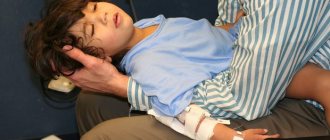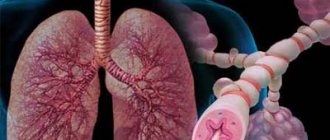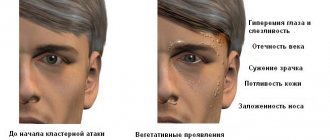Etiology and pathogenesis
The disease is inherited in an autosomal recessive manner. It appears to be based on an inborn error of metabolism, but the primary biochemical defect has not yet been identified. Both sexes get sick equally often. S. N. Davidenkov (1936) believed that the complex picture of Myoclonus epilepsy is an expression of the peculiar pleiotropism of the gene for this disease. Parents of patients with Myoclonus epilepsy can be healthy (there are often cases of their consanguinity). In relatives of patients with M.-e. other diseases of c are also observed. n. With. - epilepsy, parkinsonism, chorea, mental retardation, alcoholism, etc. Isolates with a relatively high frequency of M.-e. Along with familial cases, there are many sporadic cases.
Pathological anatomy
A postmortem examination reveals dystrophic changes in the brain, most pronounced in the dentate nucleus of the cerebellum, olives of the medulla oblongata, substantia nigra, striatum, thalamus (visual thalamus), and in different parts of the cerebral cortex. A characteristic, but not obligatory histopathological sign of M.-e. is the presence of one or two spherical amyloid inclusions mainly in nerve cells, which were discovered by Lafora (GR Lafora, 1911) and named after him. Lafora bodies are found not only in ganglion cells of the brain and spinal cord, but also in the roots of the spinal nerves, in peripheral nerves, skeletal muscles, liver, and spleen. Many nerve cells also contain significant accumulations of lipofuscin.
Reasons for the development of the disease
Currently, there are quite a lot of diseases that are accompanied by short-term seizures. If such symptoms occur, the reasons for its development should be found out.
The most common factors that contribute to the occurrence of myoclonic seizures are:
- increased physical activity;
- stress and emotional distress;
- insufficient intake of vitamins and minerals into the body;
- long-term use of caffeine-containing drugs;
- nicotine addiction;
- negative reaction to certain medications (estrogen, corticosteroids).
A short-term myoclonic spasm may indicate a magnesium deficiency in the body.
Quite often, cramps that are provoked by such reasons affect the fingers, eyelids and calves of the legs. As a rule, such a cramp is short-lived and stops on its own, without requiring serious treatment.
In addition, there are more serious factors that provoke myoclonus. These include:
- dystrophic changes in muscle tissue;
- the development of amyotrophic sclerosis, which is accompanied by the death of nerve cells;
- spinal muscular atrophy;
- muscle nerve injuries;
- autoimmune diseases (Isaac syndrome), etc.
Despite the fact that myoclonic seizures, in most cases, do not pose a danger, any manifestations of this nature require consultation with a doctor and a thorough examination of the patient to exclude more serious symptoms.
Clinical picture
In most cases, the disease begins at the age of 10-15 years. It is characterized by a combination of myoclonic hyperkinesis with epileptic seizures. In some patients, the first symptoms are myoclonus (see), and general epileptic seizures (see Epilepsy), usually nocturnal, occur later, often after a number of years. In other patients, only epileptic seizures are initially observed, without myoclonic hyperkinesis, which appears later. In addition to grand mal seizures with loss of consciousness, clonic-tonic convulsions, urinary incontinence, tongue biting, other manifestations of epilepsy may occur - petit seizures, absence seizures (a type of minor epileptic seizure), twilight states, etc.
With M.-e. myoclonic hyperkinesis is characterized by great diversity and has its own characteristics. Initially occurring clonic twitches are often isolated and can be observed in one muscle; The quadriceps femoris muscle contracts predominantly, with little motor effect. In the future, myoclonus becomes more and more common, affecting the muscles of the limbs, torso, and head, and their frequency and motor effect increase.
In most cases, myoclonus is observed at a fast pace, lightning fast, erratic, arrhythmic, asynchronous, and irregular. They decrease significantly and stop in a calm state, in a supine position, and are absent during sleep. They are intensified by voluntary movements and emotions, especially negative ones. The so-called sensoroclonic reactions - an unexpected bright light or loud sound causes a short-term myoclonic attack in the form of a sudden increase in muscle contractions in the limbs, torso, face with sharp general shudders.
Myoclonic hyperkinesis manifests itself to varying degrees on different days - it can subside significantly or, conversely, intensify, and therefore patients themselves note an alternation of “good” and “bad” days. Sometimes some patients experience psychotonic attacks described by Lundborg. They are expressed in the fact that, under the influence of emotional influences, the patient experiences short-term tonic tension of the entire muscles without loss of consciousness.
Rare combinations of myoclonic hyperkinesis with choreoathetosis have been described (see Hyperkinesis). There is a close connection between myoclonic hyperkinesis and epileptic seizures. Day after day, the increasing myoclonus gradually becomes especially pronounced, at the height of which the patient loses consciousness for a short time, clonic-tonic convulsions appear with tongue biting and urinary incontinence. After the end of the epileptic seizure, myoclonus immediately disappears, usually for one or two days, and then it appears again and gradually intensifies. Myoclonus epilepsy has a progressive course. Due to myoclonus, it is difficult and gradually becomes impossible for patients to walk and perform other voluntary movements; they cannot care for themselves or eat food on their own. Some patients experience mild cerebellar disorders (ataxia, intention tremor), muscle hypotonia. Sensitivity is preserved. No paresis or reflex disorders were noted. In the later stages of the disease, extrapyramidal immobility develops with a wedge, a picture of parkinsonism (see), while myoclonic hyperkinesis disappears.
With few exceptions, patients deteriorate mentally.
In the early stages of the disease, asthenoneurotic disorders are noted, later the patients become more and more lethargic, apathetic, interest in the environment decreases, memory deteriorates, intelligence and criticism weaken, at times lethargy is replaced by irritability, there are states of confusion with hallucinatory experiences, many develop severe dementia (see . Dementia). An electroencephalographic study (see Electroencephalography) often reveals paroxysms of high amplitude electrical activity. Light stimulation and hyperventilation increase paroxysmal electrical activity of the brain. A decrease in the content of mucopolysaccharides is often detected in the blood serum of patients. According to some authors, for M.-E. An increased concentration of arginine succinic acid in the blood is also characteristic.
Types of myoclonic seizures
Depending on the location of the nervous system disease, doctors distinguish groups of attacks:
- the cortical group of seizures received its name due to external stimuli (sharp scream, bright light). Due to unexpected stimuli, an epileptic discharge is formed in the brain;
- a stem, or subcortical, attack occurs against the background of irritation of the cerebellum. Spasm and twitching of the proximal muscle tissue occurs;
- spinal myoclonus occurs in the clinic of infarction conditions, inflammatory processes, tumor-like and degenerative conditions, spinal injuries;
- the peripheral group of seizures is associated with damage to the peripheral nerves.
Convulsive attack
Diagnosis
The diagnosis is made on the basis of a combination in a wedge, a picture of myoclonic hyperkinesis with epileptic seizures. The family nature of the disease is important for diagnosis. The differential diagnosis is made with a very similar cerebellar myoclonic dyssynergia of Hunt - a hereditary, autosomal recessive disease, in which myoclonic hyperkinesis and epileptic seizures are also observed, but, unlike M.-e., cerebellar disorders are much more pronounced. Unlike M.-e., with Kozhevnikov epilepsy (see), clonic convulsions are observed in a certain part of the body and are usually not of a generalized nature. It is especially difficult to establish an early diagnosis in sporadic cases when the disease manifests itself as an incomplete wedge, syndrome - either epileptic seizures or myoclonic hyperkinesis. In this case, family history is important, as well as a decrease in the content of mucopolysaccharides in the blood serum.
Seizure symptoms
Doctors identify the symptoms of myoclonus:
- “restless legs”, there are shaking movements of the legs;
- stereotypical paroxysmal movements.
Condition syndromes include bruxitis, thumb sucking, sleep talking, asthmatic attack, vomiting, nightmares and a feeling of “suffocation.” Myoclonus of the calf muscles is similar to cramps. With convulsive conditions, a person loses consciousness, but with myoclonus, he does not. Spasms of the calf muscles appear during the sleep phase. Spastic movements in the calf muscles in women are caused by uncomfortable shoes or constant wearing of high-heeled shoes. Myoclonus appears in the clinic of varicose veins. In addition to spasms, swelling develops in the calf muscles. Tonic-clonic seizures are accompanied by loss of consciousness.
Treatment and Prognosis
Treatment is symptomatic. Anticonvulsant therapy is used, phenobarbital, benzonal, seduxen, chloral hydrate are prescribed. The last two remedies can significantly reduce myoclonic hyperkinesis for a short time. The use of chloral hydrate can cause addiction to it and the rapid development of cachexia. Repeated long-term courses of treatment with glutamine are also indicated.
The prognosis is unfavorable. Average duration of illness approx. 20 years, some patients live to old age. The most common cause of death is increasing cachexia, often pneumonia and other intercurrent diseases.
Spouses whose family has a patient with myoclonus epilepsy are advised to seek medical genetic consultation to resolve the issue of having a child (see).
Bibliography:
Davidenkov S.N. Myoclonus-epilepsy, in the book: Neurol. and genetics, ed. S. N. Davidenkova, vol. 2, p. 195, M., 1936; Dzerzhinsky V. Myoclonia Unverricht'a, Zhurn, neuropathist, and psychiatrist, book. 5-6, p. 293, 1910; McKusick V. A. Hereditary characteristics of man, trans. from English, M., 1976; Melnikov S.A. Myoclonus-epilepsy as a syndrome in certain diseases of the brain, Zhurn, neuropath, and psychiat., t. 57, century. 6, p. 740, 1957, bibliogr.; de Ajuriaguerra J., Sigwald J. et Piot C. Myoclonie-epilepsie familiare de type Unverricht, Presse med., p. 1813, 1954; Bogaert L. Sur l'epilepsie-myoclonie progressive d'Unverricht - Lundborg, Mschr. Psychiat. Neurol., Bd 118, S. 170, 1949, Bibliogr.; Davison Ch. a. Keshner M. Myoclonus epilepsy, Arch. Neurol. Psychiat. (Chic.), v. 43, p. 524, 1940; Gambetti P. ao Myoclonic epilepsy with lafora bodies, Arch. Neurol. (Chic.), v. 25, p. 483, 1971; Hallidau AM Les differents types des myoclonies, Rev. neurol., t. 119, p. 135, 1968; Handbook of clinical neurology, ed. by PJ Yinken a. G. W. Bruyn, v. 15, p. 121, 1974, v. 27, p. 171, Amsterdam ao, 1976; Lafora GR u. Glueck B. Beitrag zur Histopathologie der myoclonischen Epilepsie, Z. ges. Neurol. Psychiat., Bd 6, S. 1, 1911, Bibliogr.; LundborgH. Die progressive Myoclonus-Epilepsy, Upsala, 1903; Unverricht H. Die Myoclonie, L]3z.—Wien, 1891.
R. A. Tkachev.









